Rikaline GPS-25
GPS Board
User’s Guide
SiRF Star III V1.0 Feb 20, 2006
Rikaline International Corp.
14F, 171, Chen-Gong Road, San-Chong City, Taipei 241, Taiwan
Phone: +886-2-8973-1899 Fax: +886-2-8973-1896
E-Mail: info@rikaline.com.tw Web: www.rikaline.com.tw
All Right Reserved
�
GPS-25 Operating Manual Rikaline
TABLE OF CONTENTS
3
3
3
3
1. Introduction ………………………………………………………………………………………..
1.1 Overview ……………………………………………………………………………………..
1.2 Features ……………………………………………………………………………………..
1.3 Technical Specifications ………………………………………………………………..
2. Operational Characteristics ……………………………………………………………….… 5
5
5
2.1 Initialization ………………………………………………………………………………….
2.2 Navigation ………………………………………………………………………………….
3. Hardware Interface ………………………………………………………………………….…… 6
3.1 Physical Characteristics ……………………………………………………………….… 6
3.2 Hardware …..…………………..……………………………………………………….…… 6
3.3 Connector ………………………………………………………………………………….… 6
3.4 Pad Assignment …………………………………………………………………………… 6
3.5 Other function description …………………………………………..………………… 8
4. Software Interface …………………………………………………………………………….… 9
4.1 NMEA Transmitted Sentences ……………………………………………………..… 9
4.2 RTCM Received Data ………………………………………………………………….. 12
5. Earth Datums & Output Setting ……………………………………………………………. 13
5.1 Earth Datums ……………………………………………………………………………….. 13
5.2 Output Setting …………………………………………………………………………….… 13
6. Ordering Information ………………………………………………………………………..… 14
6.1 Product Options ………………………………………………………………….………… 14
6.2 Accessories ………………………………………………………………………….……… 14
7. Warranty ……………………………………………………………………………………………… 18
Rikaline International Corp. 14F, 171, Cheng-Gong Road, SanChung City, Taipei 241, Taiwan
Tel: ++886 2 8973 1899 Fax: ++886 2 8973 1896 E-Mail: info@rikaline.com.tw web: www.rikaline.com.tw
2
�
GPS-25 Operating Manual Rikaline
1. Introduction
1.1 Overview
The Rikaline GPS-25 GPS Engine Board is designed based on SiRF Star III new generation
architecture with low power consumption, small size and easy integrated for a broad spectrum of OEM
system applications. It acquires satellite 20 channel parallel and tracking 12 at a time. The 200,000 effective
correlators ensure fast TTFF and fast TTFF at low signal level.
The GPS-25 meets strict needs such as car navigation, mapping, surveying, security, agriculture and so on.
Only clear view of sky and certain power supply are necessary to the unit. It communicates with other
electronic utilities via compatible TTL and saves critical satellite data by built–in backup memory. The
Trickle-Power allows the unit operates a fraction of the time and Push-to-Fix permits user to have a quick
position fix even though the receiver usually stays off.
For flexible design of your system, we provide you GPS-25 with embedded passive antenna and active
antenna connector on board. There is an electric switch between the 2 type antennas to maximize the
advanced performance.
1.2 Features
The GPS-25 provides a host of features that make it easy for integration and use.
1. SiRF Star III chipset with embedded ARM7TDMI CPU available for customized applications in
2. High performance receiver acquires 20 channel parallel and tracks up to 12 satellites while providing first
fast fix and low power consumption.
3. Differential capability utilizes real-time RTCM corrections producing 1-5 meter position accuracy.
4. Compact design ideal for applications with minimal space.
5. A rechargeable battery sustains internal clock and memory. The battery is recharged during normal
6. User initialization is not required.
7. Dual communication channels and user selectable baud rates allow maximum interface capability and
firmware.
operation.
flexibility.
8. Optional customer design for any possible size down to 16 x 20mm.
9. FLASH based program memory: New software revisions upgradeable through serial interface.
10. Built-in WAAS and EGNOS demodulator (optional software).
1.3 Technical specifications
1.3.1 Physical Characteristics
Dimension: 42(L) x 32(W) x 10.5(H) mm
1.65"(L) x 1.26"(W) x 0.41"(H).
Weight: 33g
1.3.2 Environmental Characteristics
1) Operating temperature: -40oC to +85oC
2) Storage temperature: -55oC to +100oC.
1.3.3 Electrical Characteristics
Input voltage: +3.0 ~ 6.0 VDC
1)
2) Backup power: 3V Rechargeable Lithium cell battery, up to 230 hours (9.5 days) discharge.
Rikaline International Corp. 14F, 171, Cheng-Gong Road, SanChung City, Taipei 241, Taiwan
Tel: ++886 2 8973 1899 Fax: ++886 2 8973 1896 E-Mail: info@rikaline.com.tw web: www.rikaline.com.tw
3
�
GPS-25 Operating Manual Rikaline
1.3.4 Performance
1) Acquisition: 20 channel parallel
2) Tracking: up to 12 satellites
3) Update rate: 1 second
4) Acquisition time
Reacquisition 0.1 sec., averaged
Snap Start 3 sec, averaged
6 sec, averaged
38 sec., averaged
42 sec., averaged
4) Position accuracy:
Hot start
Warm start
Cold start
A) Non DGPS (Differential GPS)
Position
Velocity
Time
<10 M at 2D RMS
0.1 meters/second, with SA off
1 microsecond synchronized GPS time
B) DGPS (Differential GPS) or WAAS / EGNOS
1 ~ 5 meter, typical
0.05 meters/second, typical
Position
Velocity
5) Dynamic Conditions:
6) Time Mark PPS
Altitude
Velocity
Acceleration
Jerk
18,000 meters (60,000 feet) max
515 meters / second (1000 knots) max
4 G, max
20 meters/second, max
TTL
Level
Pulse Duration 100ms
Time Reference at the pulse positive edge
Measurements Aligned to GPS second, ± 1 microsecond
1.3.5 Interfaces
1) Dual channel TTL compatible level, with user selectable baud rate (4800, 9600-Default, 19200, 38400).
2) NMEA 0183 Version 2.2 ASCII output (GPGGA, GPGLL, GPGSA, GPGSV, GPRMC, GPVTG).
3) SiRF protocol--- Position, Velocity, Altitude, Status and Control
Rikaline International Corp. 14F, 171, Cheng-Gong Road, SanChung City, Taipei 241, Taiwan
Tel: ++886 2 8973 1899 Fax: ++886 2 8973 1896 E-Mail: info@rikaline.com.tw web: www.rikaline.com.tw
4
�
2. Operational characteristics
GPS-25 Operating Manual Rikaline
2.1 Initialization
As soon as the initial self-test is complete, the GPS-25 begins the process of satellite acquisition and
tracking automatically. Under normal circumstances, it takes approximately 42 seconds to achieve a position
fix, 38 seconds if ephemeris data is known. After a position fix has been calculated, information about valid
position, velocity and time is transmitted over the output channel.
The GPS-25 utilizes initial data, such as last stored position, date, time and satellite orbital data, to achieve
maximum acquisition performance. If significant inaccuracy exists in the initial data, or the orbital data is
obsolete, it may take more time to achieve a navigation solution. The GPS-25 Auto-locate feature is capable
of automatically determining a navigation solution without intervention from the host system.
2.2 Navigation
After the acquisition process is complete, the GPS-25 sends valid navigation information over
output channels. These data include:
1) Latitude/longitude/altitude
2) Velocity
3) Date/time
4) Error estimates
5) Satellite and receiver status
The GPS-25 sets the default of auto-searching for real-time differential corrections in RTCM SC-104
standard format, with the message types 1, 5, or 9. It accomplishes the satellite data to generate a differential
(DGPS) solution. The host system, at its option, may also command the GPS-25 to output a position
whenever a differential solution is available.
Rikaline International Corp. 14F, 171, Cheng-Gong Road, SanChung City, Taipei 241, Taiwan
Tel: ++886 2 8973 1899 Fax: ++886 2 8973 1896 E-Mail: info@rikaline.com.tw web: www.rikaline.com.tw
5
�
GPS-25 Operating Manual Rikaline
3. Hardware interface
3.1 Physical Characteristics
Dimension: 42(L) x 32(W) x 10.5(H) mm
1.65"(L) x 1.26"(W) x 0.41"(H).
Dimension in mm
Weight: 17.6g
3.2 Hardware
3.3 Connectors
3.3.1 Antenna Connector
It is designed with MMCX for active antenna.
3.3.2 Interface Connector
10 pin connector with 1.27mm pitch.
3.4 Pin Assignment
Table 3-1 Pin definition of the 10 Digital Interface
Pad Number
Name
Description
1
2
3
4
5
6
7
8
VCC IN
BACKUP BAT
GND
RX (TTL)
TX (TTL)
PPS / DGPS
GPIO
GPS STATE
3-6Vdc
For backup battery
Ground
Serial data input
Serial data output
One of these functions active at a time
Spare I\O for customer software
For LED indication
Rikaline International Corp. 14F, 171, Cheng-Gong Road, SanChung City, Taipei 241, Taiwan
Tel: ++886 2 8973 1899 Fax: ++886 2 8973 1896 E-Mail: info@rikaline.com.tw web: www.rikaline.com.tw
6
�
GPS-25 Operating Manual Rikaline
9
10
P-T-F
RESET
Table 3-2 Operating Conditions
Parameter
Power Supply Voltage
Power Supply Voltage
Operating Temperature
Operating Current
Symbol
VCC IN
BACKUP BAT
TOPR
ICC
Table 3-3 Battery Conditions
Parameter
RTC (Battery) Power
Supply Current
Symbol
BACKUP BAT
PUSH-TO-FIX
System Restart
Min
3.0
1.4
-40
Min
1.4
Type
5.0
1.5
90
Typ
1.5
10
Max
6.0
1.6
85
Max
1.6
Units
V
V
ºC
mA
Units
V
µA
3.4.1 VCC IN
It power range is from 3.0Vdc to 6.0Vdc.
3.4.2 BACKUP BAT
3.4.3 GND
It requires 1.5Vdc and the function is to keep the GPS clock running in the system for quick position fix
next time.
The GND provides the ground for the board. All GND should be connected.
3.4.4 Rx (TTL)
This pad is for data Input to control the GPS output or GPS system setting
3.4.5 Tx (TTL)
It outputs standard NMEA 0183 V2.2 sentences, SiRF binary or either one of NMEA and SiRF binary
3.4.6 DGPS / PPS Time mark (R7 DGPS / R10 PPS)
This pin can have one function of the two active. If the on-board resistance, R7 connected and R10
Open, pin 6 accepts DGPS signal. If R7 open and R10 connected, it outputs PPS signal.
Real-time Differential Correction input (RTCM SC-104 version 2.00 message types 1, 5 and 9). For
use with Radio-Beacon for positioning correction. It always requires baud rate at 9600.
3.4.6.1 DGPS
3.4.6.2 PPS Time Mark
This function provides 1 pulse per second output from the board, which is synchronized to within 1
microsecond of GPS time. The output is a CMOS (TTL) level signal.
3.4.7 SPARE GPIO Functions
This I/Os of CPU is connected to the digital interface connector for consumer applications.
3.4.8 GPS LED
To have GPS positioning status visible. Default: Blinking (Power ON) and ON (position fix)
3.4.9 Push-to-Fix Description
The Push-to-Fix mode is for the applications that requires infrequent position reporting. The receiver
generally stays in a low-power mode, up to 2 hours, but wakes up periodically to refresh position, time,
ephemeris data and RTC calibration. A position request acts as a wakeup to the receiver, which is
then able to supply a position within the hot-start time specification.
Rikaline International Corp. 14F, 171, Cheng-Gong Road, SanChung City, Taipei 241, Taiwan
Tel: ++886 2 8973 1899 Fax: ++886 2 8973 1896 E-Mail: info@rikaline.com.tw web: www.rikaline.com.tw
7
�
GPS-25 Operating Manual Rikaline
3.4.10 RESET
This function provides an active-low reset input to the board. It causes the board to reset and start
searching for satellites. It is an optional input and, if not utilized, it may be left open.
3.5 Other Function Description
3.5.1 TricklePowerTM
In this state, the CPU is in a low power standby state and the receiver clocks are off with only the
Description
RTC clock active. After a set amount of time, the RTC generates an NMI signal to wake up the
ARM-7 microprocessor and reset the receiver back to tracking state.
Rikaline International Corp. 14F, 171, Cheng-Gong Road, SanChung City, Taipei 241, Taiwan
Tel: ++886 2 8973 1899 Fax: ++886 2 8973 1896 E-Mail: info@rikaline.com.tw web: www.rikaline.com.tw
8
�
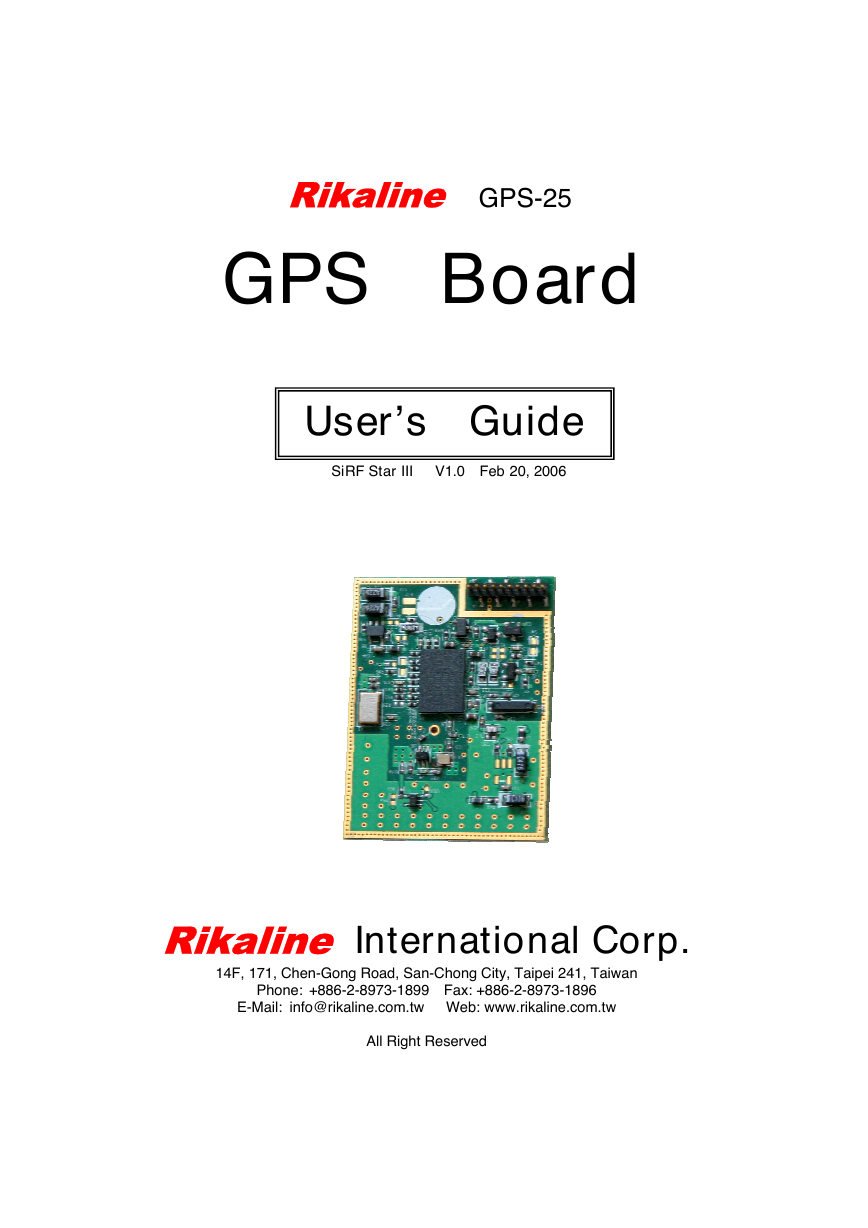
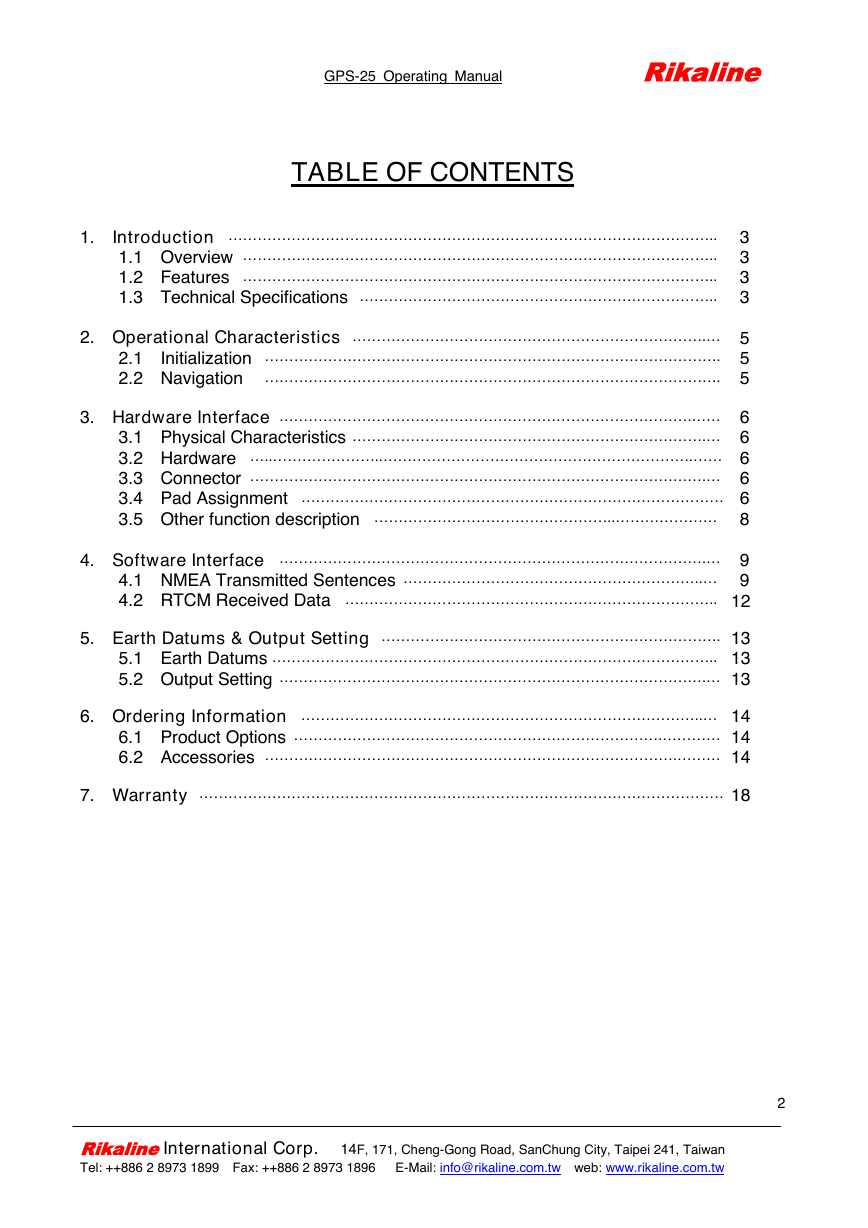
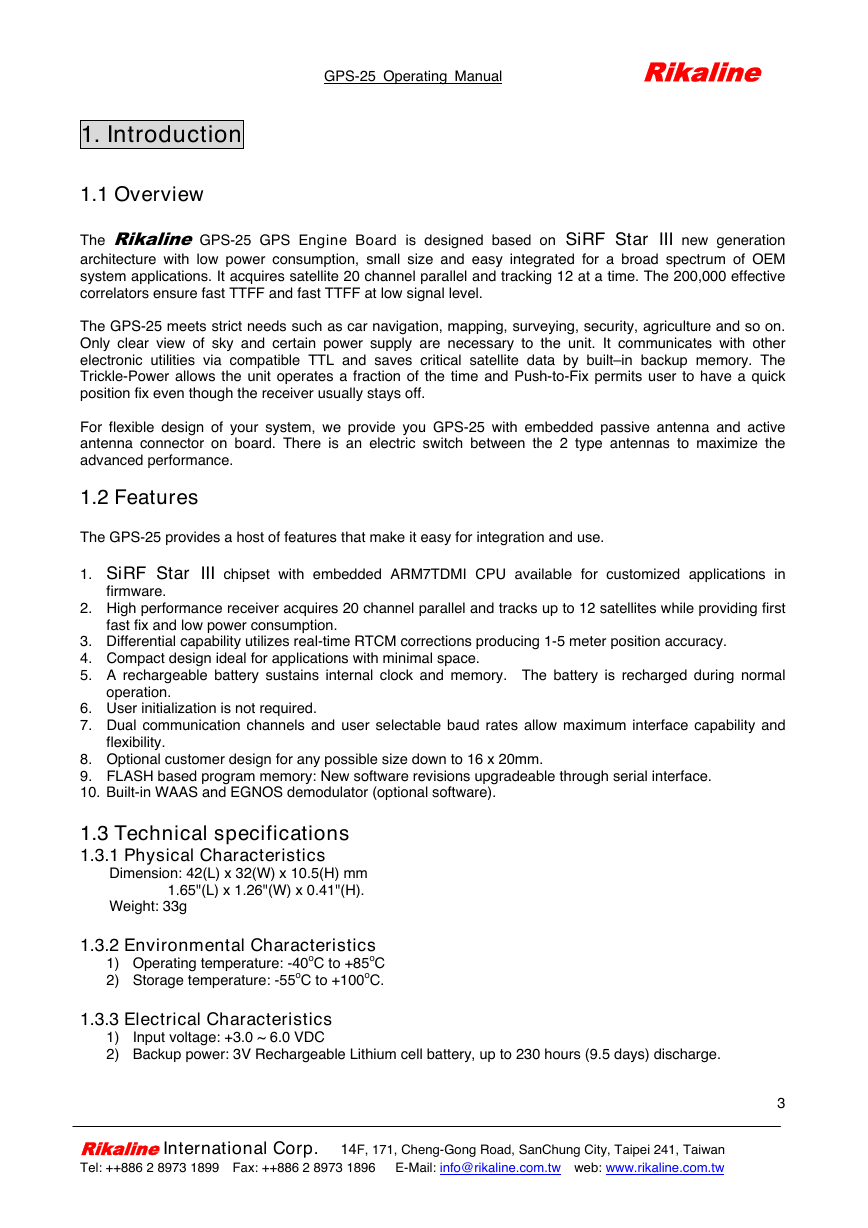
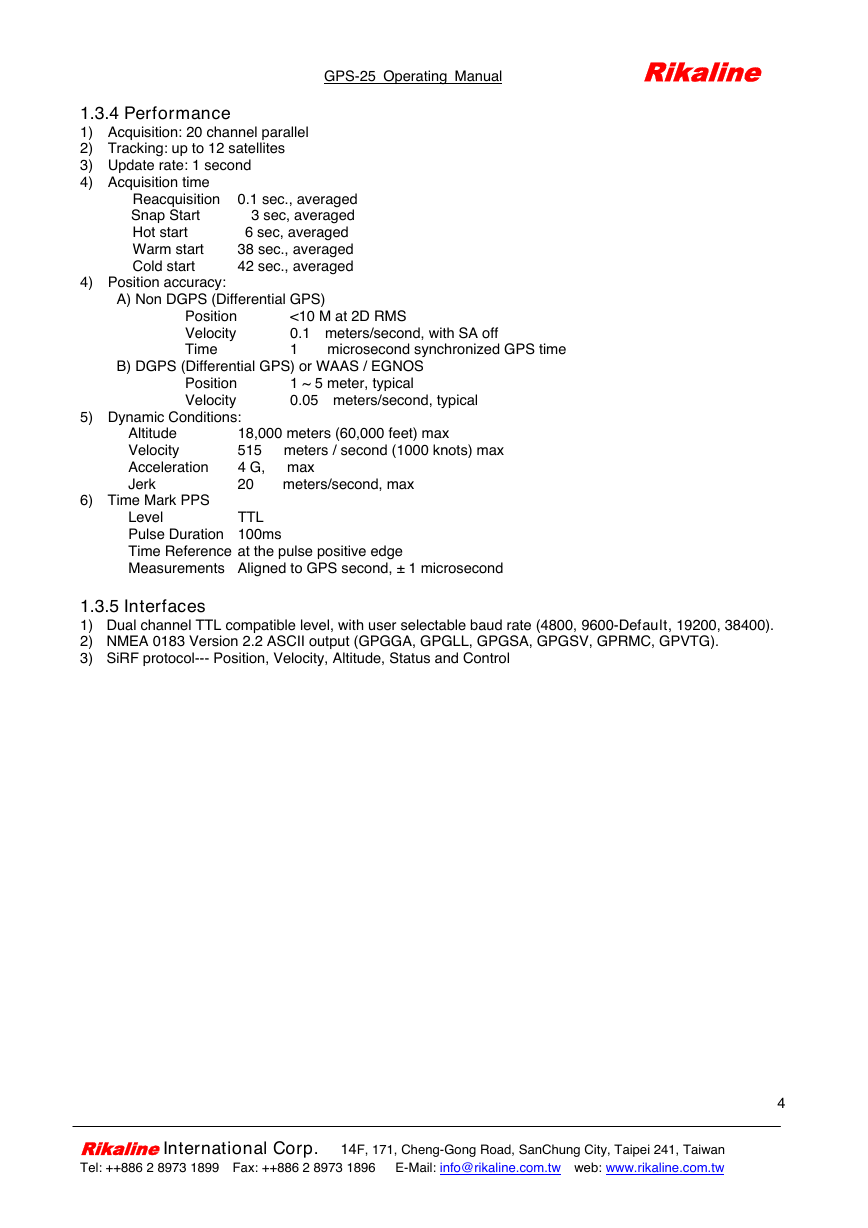

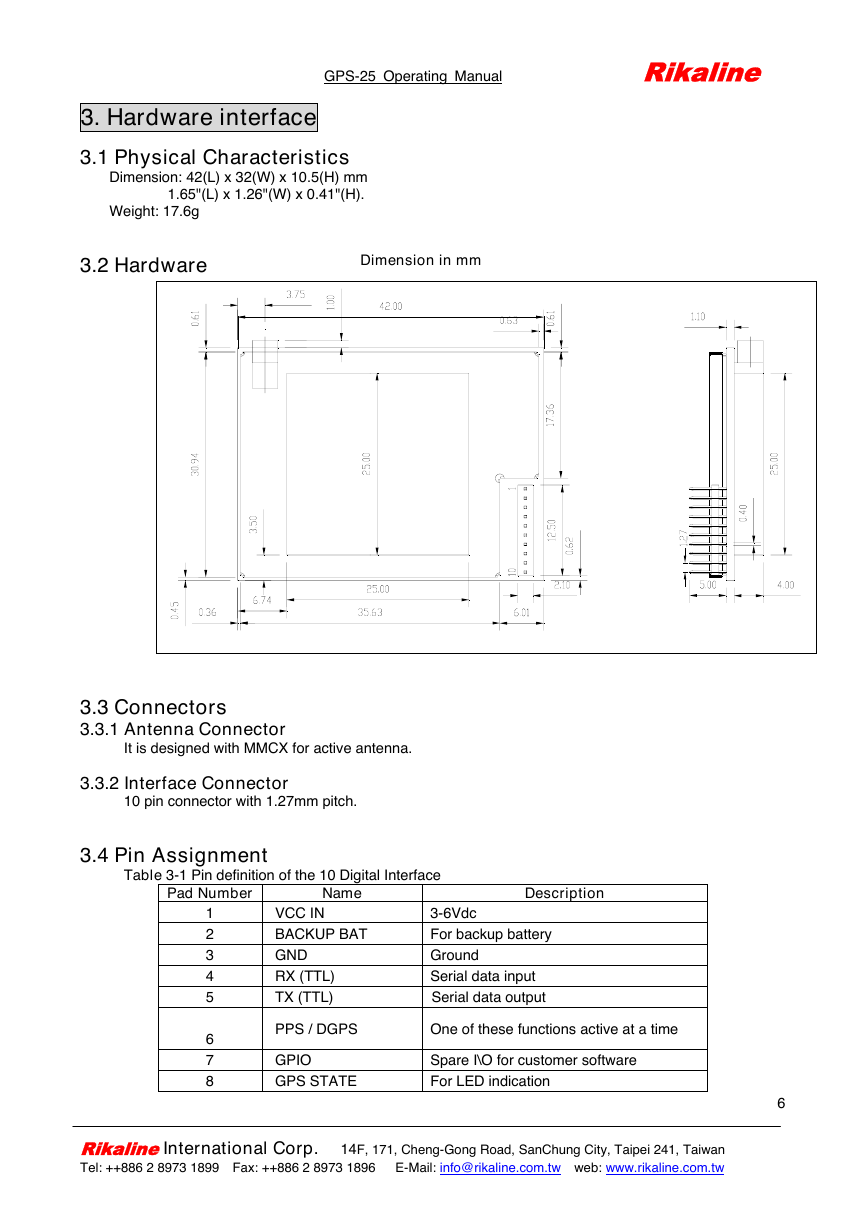










 2023年江西萍乡中考道德与法治真题及答案.doc
2023年江西萍乡中考道德与法治真题及答案.doc 2012年重庆南川中考生物真题及答案.doc
2012年重庆南川中考生物真题及答案.doc 2013年江西师范大学地理学综合及文艺理论基础考研真题.doc
2013年江西师范大学地理学综合及文艺理论基础考研真题.doc 2020年四川甘孜小升初语文真题及答案I卷.doc
2020年四川甘孜小升初语文真题及答案I卷.doc 2020年注册岩土工程师专业基础考试真题及答案.doc
2020年注册岩土工程师专业基础考试真题及答案.doc 2023-2024学年福建省厦门市九年级上学期数学月考试题及答案.doc
2023-2024学年福建省厦门市九年级上学期数学月考试题及答案.doc 2021-2022学年辽宁省沈阳市大东区九年级上学期语文期末试题及答案.doc
2021-2022学年辽宁省沈阳市大东区九年级上学期语文期末试题及答案.doc 2022-2023学年北京东城区初三第一学期物理期末试卷及答案.doc
2022-2023学年北京东城区初三第一学期物理期末试卷及答案.doc 2018上半年江西教师资格初中地理学科知识与教学能力真题及答案.doc
2018上半年江西教师资格初中地理学科知识与教学能力真题及答案.doc 2012年河北国家公务员申论考试真题及答案-省级.doc
2012年河北国家公务员申论考试真题及答案-省级.doc 2020-2021学年江苏省扬州市江都区邵樊片九年级上学期数学第一次质量检测试题及答案.doc
2020-2021学年江苏省扬州市江都区邵樊片九年级上学期数学第一次质量检测试题及答案.doc 2022下半年黑龙江教师资格证中学综合素质真题及答案.doc
2022下半年黑龙江教师资格证中学综合素质真题及答案.doc